Development of a Reference Measurement Procedure for C-Reactive Protein in Human Serum
Summary
C-reactive protein (CRP) levels in serum or plasma have been used as an indicator of inflammation and infection. Recent evidence also suggests that CRP levels may have value in identifying individuals at greater risk of a heart attack. A clinical diagnostic test known as the high-sensitivity CRP (hsCRP) test has been used to assess the risk of heart disease and heart attack. Currently there are no certified reference materials for CRP at normal (< 1.0 mg/L) and moderately elevated levels. This is primarily because of a lack of higher-order methods that can be used to value assign such reference materials. NIST is taking the first steps toward development of a reference measurement procedure that can be used to assess the accuracy of routine clinical laboratory tests for CRP.
Description

Computer-generated image of the structure for C-reactive protein
Two basic types of CRP tests are commonly employed in clinical laboratories. The hsCRP test has improved sensitivity and is better suited to screening of apparently healthy individuals for potential heart disease risk. Current hsCRP tests have been standardized to ERM/IFCC DA-470, a certified reference material (CRM) for proteins in human serum. A new preparation of ERM DA-470 was recently issued, and this new issue of the CRM does not have a certified value for CRP. Both reference measurement procedures and reference materials are needed to provide an accuracy basis for routine laboratory measurements for CRP. By developing a mass spectrometry-based reference measurement procedure for the quantification of CRP in human serum and plasma, NIST will be positioned to help ensure that results from hsCRP tests can meaningfully guide medical treatment decisions.
CRP is generally present in low abundance relative to other serum proteins. As a result, direct quantitation of CRP at normal levels in serum by mass spectrometry is problematic. An affinity purification technique, using a magnetic bead coupled to a monoclonal antibody against CRP, was employed to isolate CRP from the complex mixture of proteins in serum and improve the feasibility of mass spectrometric quantification. A recombinant form of CRP (rCRP) was produced in E. coli with media containing 15N-ammonium chloride as the only nitrogen source. The resulting rCRP was of high purity (> 99%) and possessed a high level of 15N incorporation (> 99%). Mixtures of CRP and 15N-rCRP were combined in specific ratios, subjected to affinity purification, tryptic digestion, and analysis by LC-MS/MS. The results of quantitation were linear over the range of CRP concentrations studied, indicating that CRP and 15N-rCRP exhibit similar antibody binding and digestion characteristics. A commercially available serum control material for CRP was analyzed in a similar manner, using 15N-rCRP as the internal standard, and a value of 1.3 mg/L was obtained, in good agreement with the manufacturer-assigned value. These results indicate that the methodology can be used to quantify CRP in serum at levels of clinical diagnostic significance.
Major Accomplishments:
- An affinity purification approach using a monoclonal antibody against CRP has been developed to isolate CRP from human serum.
- An isotope-dilution approach to CRP quantitation has been demonstrated using 15N-rCRP as an internal standard.
- CRP has been quantified in human serum at levels that were previously not achievable by LC-MS/MS.

